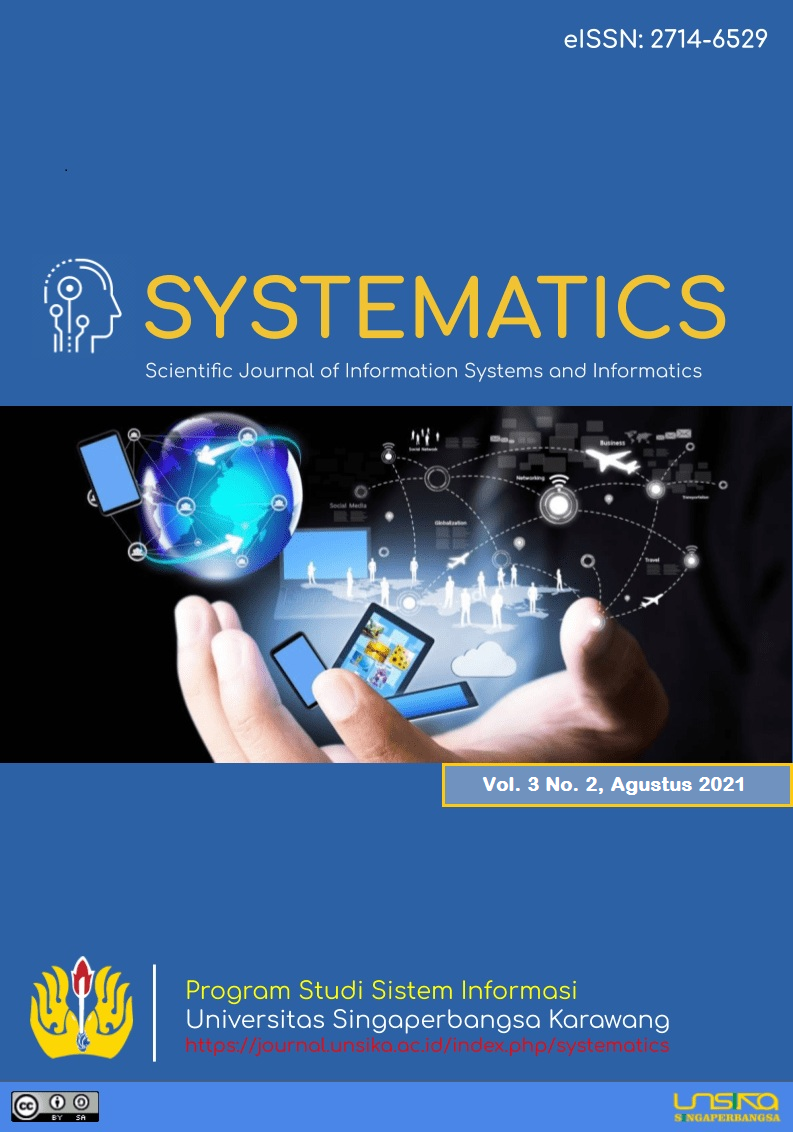Classification of Super Air Jet Initial Cabin Crew Candidates Using K-Nearest Neighbor (KNN) Method
Klasifikasi Calon Awak Kabin Awal Super Air Jet Menggunakan Metode K-Nearest Neighbor (KNN)
DOI:
https://doi.org/10.35706/sys.v3i2.5804Abstract
At the time of the corona virus outbreak that hit Indonesia and the world which had an impact on various sectors including transportation, optimistically that the Indonesian domestic flight market was still open with strong demand, a new airline, Super Air Jet (SAJ) was created in March 2021. In an effort to improve SAJ services screening qualified human resources, including the process of screening candidates for initial cabin crew. To support this process, it is necessary to have a method used to classify candidates for initial cabin crew at the administrative stage. K-Nearest Neighbor (KNN) which is one method for classifying is expected to provide a solution to the problems discussed. This study uses 10 training data that have 8 criteria to predict categories in 6 test data. From the calculation results using a value of k=5, the same results as the label on the initial test data resulted, which resulted in 2 data with the Stop prediction class and 4 data with the Advanced prediction class. To measure the performance of the KNN method, a test was conducted using a confusion matrix which resulted in a 100% accuracy value, a 100% precision value and a 100% recall value.
Downloads
References
Kemenkes, “Status Wabah Corona di Indonesia Ditetapkan sebagai Bencana Nasional,” kemkes.go.id, Jakarta, Mar. 15, 2020.
Puspa A. W, “Kantongi Izin AOC, Super Air Jet Segera Terbangkan 3 Pesawat A320-200,” ekonomi.bisnis.com, 2021.
Murti M. W, “Super Air Jet, All-Indonesian Low-cost Carrier Launches,” en.tempo.co, Jakarta, May 03, 2021.
Rahma A, “Potret Pramugari Super Air Jet, Maskapai Baru Bergaya Milenial,” www.liputan6.com, May 03, 2021.
SAJ S. A. J, “Kisah Super Air Jet,” superairjet.com, 2021. (accessed 2021).
Khormarudin A. N, “Teknik Data Mining: Algoritma K-Means Clustering,” J. Ilmu Komput., pp. 1–12, 2016.
Nugraha A. R. D., Auliasari K., & Pranoto Y. A, “Implementasi Metode K-Nearest Neighbor (KNN) Untuk Seleksi Calon Karyawan Baru (Studi Kasus: BFI Finance Surabaya),” Vol 4(2), JATI (Jurnal Mhs. Tek. Inform.), 2020, pp. 14-20.
Yanosma D, Johar A, & Anggriani K, “Implementasi Metode K-Nearest Neighbor (KNN) dan Simple Addittive Weighting (SAW) dalam Pengambilan Keputusan Seleksi Anggota PASKIBRAKA,” Vol 4(2), Rekursif J. Inform., 2016, pp. 222-235.
Wahidin A. J, “Implementation of K-Means Algorithm in Determining Clustering of Lion Air Pilots,” Vol 3(1), SYSTEMATICS, 2021, pp. 211-220.
Winarso D., Arribe E. E, “Seleksi Pegawai dan Dosen UMRI Berbasis E-Recruitment Menggunakan Metode K-Nearest Neighbor,” Vol 8(2), Digit. Zo. J. Teknol. Inf. dan Komun., 2017. pp. 71-80.
Danial E., Warsinah N, Metode Penulisan Karya Ilmiah. Bandung, 2009.
Narkhede S, “Understanding Confusion Matrix,” 2018. https://towardsdatascience.com/understanding-confusion-matrix-a9ad42dcfd62 (accessed 2021).
Downloads
Published
How to Cite
Issue
Section
License
Copyright (c) 2021 SYSTEMATICS

This work is licensed under a Creative Commons Attribution-ShareAlike 4.0 International License.
Authors who publish with this journal agree to the following terms:
- Authors retain copyright and grant the journal right of first publication with the work simultaneously licensed under a Creative Commons Attribution-ShareAlike 4.0 International License. that allows others to share the work with an acknowledgement of the work's authorship and initial publication in this journal.
- Authors are able to enter into separate, additional contractual arrangements for the non-exclusive distribution of the journal's published version of the work (e.g., post it to an institutional repository or publish it in a book), with an acknowledgement of its initial publication in this journal.
- Authors are permitted and encouraged to post their work online (e.g., in institutional repositories or on their website) prior to and during the submission process, as it can lead to productive exchanges, as well as earlier and greater citation of published work (See The Effect of Open Access).







